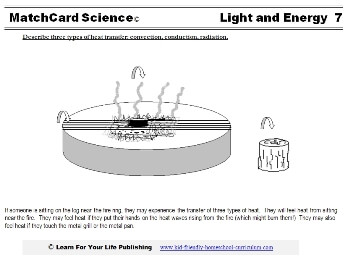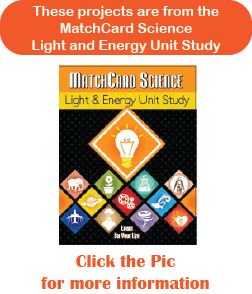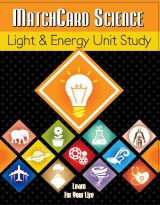Convection Conduction Radiation
Convection, Conduction, Radiation MatchCard
The Convection, Conduction, Radiation MatchCard explores the three types of heat transfer with cool science experiments and review activities.
Free Download Below


What Is On the MatchCard?
Objective: Describe three types of heat transfer: convection, conduction, and radiation.Convection = Rising of hot molecules and falling of cooler molecules in a liquid or gas
Conduction = Heating molecules of solid objects in contact with a warmer object
Radiation = Movement of infra red waves through empty space
Print the Convection, Conduction, and Radiation MatchCard


Click image to go to download.
This is MatchCard #7 of the Light and Energy Unit Study. Find more information on MatchCard Science below.
Experiment with the 3 Types of Heat Transfer
Here is a simple hands-on demonstration to introduce the three types of heat transfer. The use of a stove requires adult supervision.- Put water in a pan and let it heat to boiling on the stove.
- Start from several feet away and approach the stove (from the side, not from above.) State when you feel the warmth of the pan and hot water.
- Put a metal spoon in the pan. Feel that the spoon is also getting warmer.
- Carefully, put your hand over the rising vapor. Note the difference in the amount of heat when your hand is over the pan compared to the side of the pan.
Show the Convection, Conduction, Radiation MatchCard. Discuss the diagram of the camp fire, and compare the three types of heat transfer to their experience with the pan on the stove.
Convection
This hands-on demonstration will provide more experience with convection.- Use food coloring to dye cool water blue. Put it in an ice tray and freeze it. Wait until it is frozen to continue the experiment.
- Get a small, clear jar. A baby food jar, a measuring cup. or other small container will work well.
- Put hot water in the jar. Use red food coloring to dye the water red.
- Put a piece of aluminum foil over the jar. Use a rubber band to help secure it.
- Put the jar in a larger container. A clear mixing bowl, cookie jar, or even the kitchen sink (with a stopper in place) could work.
- Put the small jar with the hot water in the larger container. Fill it with room temperature water. Poke a hole in the foil with a knife or fork and watch what happens. (Hot molecules rise.)
- Immediately, put the blue ice cubes into the water as well. What happens? (Cool molecules fall)
- Observe for currents as the water molecules move.
Discuss that convection is caused by movement of molecules through liquid or gas.
Match the Information Pieces on the Convection Conduction Radiation MatchCard with diagram for convection.
Conduction
Use different instruments in hot water to see which conduct heat. Here are some items to consider:- metal spoon
- plastic spoon
- wooden spoon
Discuss that conduction is the transfer of heat to adjacent molecules in a solid.
Match the Information Pieces on the Convection Conduction Radiation MatchCard with diagram for conduction.
Radiation
Look for different objects in your house that radiate heat. (heater, toaster, light bulb)How far from the object can you feel the radiated heat?
Humans give off infra-red radiation. That is why a roomful of people is warmer than a room with few or no people in it.
Discuss that radiation comes from infra-red waves, a form of electromagnetic radiation that has shorter waves than visible light.
More Info on Infra-Red
You have probably heard of infra-red radiation, but do you know what it is?Infra red is one of many sizes of energy waves that comes from electromagnetic radiation. The sun is the source of most radiation, but you produce a little of it yourself.
Let’s look at the word “infra” which means “less” than red. Since red is the smallest visible light wave, infra red waves are invisible to the human eye. You can click here to learn more about electromagnetic radiation.
The Hunt
Create a list of examples of transfer of heat that the student encounters in daily life.Identify which of the three types of heat transfer occurs in each.
Encourage the use of the terms "convection," "conduction," and "radiation" as part of daily vocabulary.
Cooking Over A Fire Ring
Students are not likely to object to putting their new knowledge to use as the MatchCard suggests: over a camp fire.You can go all out with a camping trip that includes cooking over a fire three times a day.
Or perhaps a back yard bbq roasting marshmallows fits your schedule a little better this week. Either way, encourage them to experience how the heat from the fire is transferred to the environment.
MatchCard Science
How To Use MatchCards

Download the FREE MatchCard Science Instructor's Guide and see how MatchCards can make building their science knowledge base fun.
Light and Energy Unit Study

Download the entire Light and Energy unit study.
12 Science Unit Studies

Chemistry is only one of twelve complete unit studies for kids in 3rd to 8th grade.
Comprehensive objectives, hands-on projects, suggested science fair experiments, and the fun game-like MatchCards keep them interested in learning science. See all twelve MatchCard Science Unit Studies.
About Our Site
Hands-On Learning













